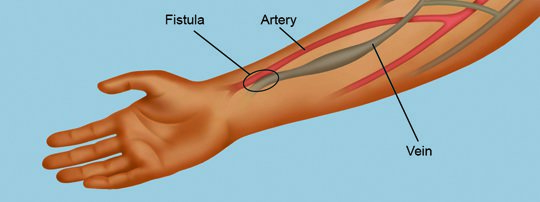Access for dialysis
All patients with chronic kidney dysfunction who require long-term dialysis need a well-functioning dialysis access to help during dialysis. An arteriovenous (AV) fistula is a surgically created connection between an artery (fast flow) and a vein (normally having slow flow). After the connection, the diameter of the vein will get enlarged (mature) and it can be used for dialysis, typically after 6–8 weeks of surgery. If dialysis is required on an urgent basis, your nephrologist would advise the placement of temporary or permanent catheter, usually in the neck. However, there is a higher risk of infection and clotting or blockage associated with this.

COMMON SITES OF AV FISTULA
The vascular specialist will choose the most appropriate site based on the size of artery and vein as well as previous injections or thrombosis.
- - Wrist
- - Forearm
- - Elbow
If earlier fistula vein has gotten blocked, or veins are not suitable for fistula, you may be advised for more complex vascular procedures like basilic vein bypass or artificial AV graft. These are more extensive surgical procedures performed in the forearm or arm, usually under a nerve block.
In some patients for whom fistula or other complex surgical procedures are not feasible or possible, your nephrologist or vascular specialist may suggest the placement of tunnelled dialysis catheters (Permcath). Under certain circumstances, your nephrologist may advice for peritoneal dialysis instead of hemodialysis
FISTULA CARE
- - A thrill is usually felt and a bruit can be heard through a stethoscope over the fistula site.
- - You would be advised to avoid measurement of BP on or blood samples from that arm
- - You would be advised to avoid measurement of BP on or blood samples from that arm
- - The vein will start becoming prominent by 6–8 weeks and can then be utilised for dialysis. However, in few patients, vein maturation can take up more time and further evaluation by Doppler or fistula angiography may be required.
IMPORTANT SIGNS TO WATCH OUT FOR
- - Bleeding:Rarely, bleeding may occur any time after the operation due to fragile veins or infection. This needs urgent attention and may require repeat surgery or even ligation of the fistula or artery
- - Blockage: Small-sized veins, decreased blood pressure, fever, dehydration or pressure at the site of fistula are known factors leading to the clotting and blockage (thrombosis) of fistula veins. A repeat surgery or angioplasty may be required to revive the fistula. Balloon angioplasty and the occasional use of stents are important techniques used to prolong the functioning life of precious dialysis fistula. However, these veins are prone to have recurrence of blockages and repeat procedures are often performed.
- - Massive swelling: Increasing swelling few days after the operation that does not reduce after 2–3 weeks may need evaluation by Doppler or angiography to detect large/central vein stenosis or occlusions. This needs prompt treatment by angioplasty
- - Slow flow OR excess bleeding after the fistula usage: These are signs of narrowing of fistula or the fistula vein and would need further evaluation by Doppler or angiography. A repeat surgery or angioplasty may be required to revive the fistula.
- - Localised swelling (aneurysm): Localised pulsatile swelling needs prompt attention by vascular specialist. An infected aneurysm can often end up with severe bleeding if not treated in time.
Source: Vascular Society of India.



